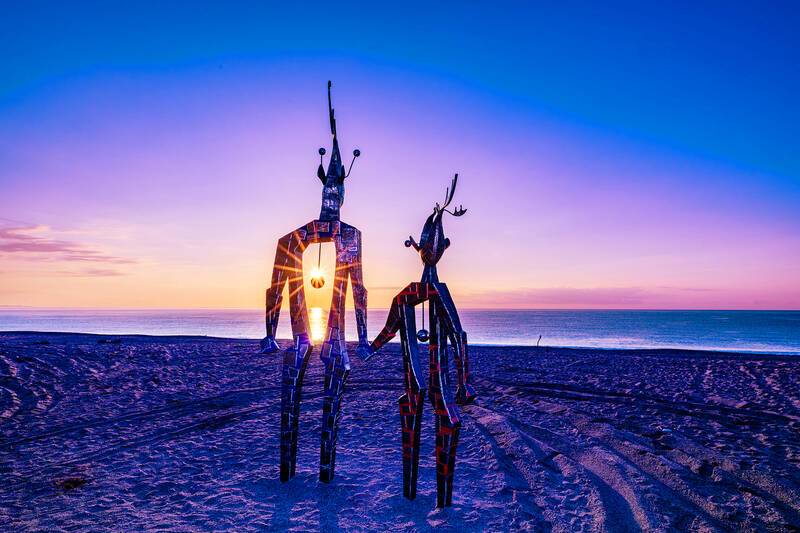In February of this year the Taipei Times reported on the visit of Lienchiang County Commissioner Wang Chung-ming (王忠銘) of the Chinese Nationalist Party (KMT) and a delegation to a lantern festival in Fuzhou’s Mawei District in Fujian Province.
“Today, Mawei and Matsu jointly marked the lantern festival,” Wang was quoted as saying, adding that both sides “being of one people,” is a cause for joy.
Wang was passing around a common claim of officials of the People’s Republic of China (PRC) and the PRC’s allies and supporters in Taiwan — KMT and the Taiwan People’s Party — and elsewhere: Taiwan and China are “one culture” or “one people.” This “shared culture” is then presented as a justification for the annexation of Taiwan. Numerous variations on this claim exist, from the hoary “same script, same race,” to the more modern attempts to use archaeology to subsume Taiwan’s indigenous people into the one-China frame.

Photo courtesy of the Taitung County Government
‘NISSEN DOSORON’
This discourse of shared culture and ancestry as an imperialist tool is hardly new. In the early twentieth century, Nissen dosoron, the Japanese “theory” that Koreans and Japanese shared a common ancestry, was a basis of Japan’s annexation of Korea. It was also used to Japanize Korea, a hint of what “one race” claims will mean for a PRC occupation of Taiwan.
Such race-based thinking is inherently imperialistic. It claims “we” are superior so we can rule over (inferior) others, or else it claims “you” are “us” so we can rule over you. The “shared culture” claim is functionally similar. In the cross-strait discourse it inevitably becomes the claim that Taiwanese are “Chinese” and there is no such thing as “Taiwanese.”
“The people of the two sides of the Taiwan Strait are all ethnic Chinese,” thundered former president Ma Ying-jeou (馬英九) in his 2013 New Years Speech. “We are all descended from the legendary Emperors Yan and Huang,” he said.
Calling Taiwanese “ethnic Chinese” is like calling Canadians “ethnic United Kingdomers.”
An old variation on the “ethnic Chinese” discourse was to refer to “subethnic groups” in Taiwan, placing them all under the rubric of “Chinese.” That term has disappeared as everyone has realized how silly it is. Another inherently imperial term, “Greater China,” has also quietly died a well-deserved death.
When “shared culture” warriors make pro-PRC claims, they generally instance cultural practices like calendars, language, scripts, festivals and so forth. These are visible manifestations of culture, shallow and easy to understand and present to others. No great education is required. More difficult to grasp is the historical experience of the Taiwanese, the actual basis of their unique identity.
That history includes the experience of Dutch, Manchu, Japanese and KMT colonization, the experience of being settlers, of being a settler region and of interactions with and resistance to the distant, indifferent ruling imperial capitals.
“Being a settler” includes centuries of interactions along a frontier between indigenous peoples and incoming Han settlers, and the way that shaped culture, identities, the built environment and landscapes and cityscapes in Taiwan. The continued existence of indigenous communities and as a distinct non-Han population today also shapes the local identity.
Another experience of Taiwanese is the ideal of democracy and its application in resistance to Japan and to the KMT. Remember, the first elections were held under the Japanese. In the modern era, this includes democratization and the lived experience of democracy.
With that has come steady and rapid long-term capitalist economic growth, for more than a century, and relative affluence and access to the outside world. Taiwan is also the site of pervasive Japanese influences in food, hygiene, expectations of social progress and order, along with pervasive US influence via increasing globalization and close economic, social, political and military ties.
Finally, in the modern era, Taiwan has experienced the desire of Chinese expansionists to annex Taiwan and suppress its local identity via both KMT colonization and PRC aggression. One of the many ironies of Taiwan history is that the Chinese desire to annex and colonize Taiwan has helped drive the development of Taiwan’s unique identity.
Needless to say, the PRC shares none of this experience. It has had its own experience with imperialism, colonization and modernization, independent of Taiwan’s.
EXPLOITING IGNORANCE, LAZINESS
Since the vastly different historical experience of Taiwan requires effort to see, the success of the “shared culture” trope depends on exploiting the ignorance and laziness of its hearers. Its constant deployment by PRC speakers in fact signals a low opinion of the rest of the world.
Though “shared culture” warriors never argue that the source of conflict is the shared culture, even the most cursory reading of history shows that states that viewed themselves as part of a broader sociocultural world spend lots of time and energy fighting each other.
The ancient Greek colonies were frequently in conflict. European states fought among themselves incessantly, as did the ancient states of China, the Arab world and India. “Shared culture” lubricates imperial ambitions by making talking and fighting easier, and letting would-be conquerors imagine the occupation will be smooth. “Shared culture” rewards conquest with higher wealth and status then dominating “barbarians” on the edges of the oikoumene.
Though many ancient Greek colonies were independent, Greek city states, colonies and their daughter colonies all participated in broader Greek world of the ancient Mediterranean. If the PRC dropped its claim to Taiwan, Taiwanese would probably be happy to participate in some imagined Sinosphere and move closer to it. The great irony of the PRC’s demand for Taiwan is that it has reified the Taiwan identity as a basis of resistance to PRC expansionism, driven the Taiwanese away and dispelled the PRC’s cultural mystique.
The trope of “shared culture” is often posited by well-meaning commentators as a potential basis for peace across the Taiwan Strait. Conventionally, it is presented as a foundation for “mutual understanding,” as if the problem between the PRC and Taiwan were a lack of understanding and not PRC death threats.
These commentators are not entirely wrong. Shared culture does lead to understanding. No nation on earth understands the PRC better than Taiwan.
Indeed, it is because of their “shared culture” that the Taiwanese understand, and resist, the expansionist lust of the PRC.
Notes from Central Taiwan is a column written by long-term resident Michael Turton, who provides incisive commentary informed by three decades of living in and writing about his adoptive country. The views expressed here are his own.

Beijing’s ironic, abusive tantrums aimed at Japan since Japanese Prime Minister Sanae Takaichi publicly stated that a Taiwan contingency would be an existential crisis for Japan, have revealed for all the world to see that the People’s Republic of China (PRC) lusts after Okinawa. We all owe Takaichi a debt of thanks for getting the PRC to make that public. The PRC and its netizens, taking their cue from the Chinese Communist Party (CCP), are presenting Okinawa by mirroring the claims about Taiwan. Official PRC propaganda organs began to wax lyrical about Okinawa’s “unsettled status” beginning last month. A Global

Dec. 22 to Dec. 28 About 200 years ago, a Taoist statue drifted down the Guizikeng River (貴子坑) and was retrieved by a resident of the Indigenous settlement of Kipatauw. Decades later, in the late 1800s, it’s said that a descendant of the original caretaker suddenly entered into a trance and identified the statue as a Wangye (Royal Lord) deity surnamed Chi (池府王爺). Lord Chi is widely revered across Taiwan for his healing powers, and following this revelation, some members of the Pan (潘) family began worshipping the deity. The century that followed was marked by repeated forced displacement and marginalization of

Music played in a wedding hall in western Japan as Yurina Noguchi, wearing a white gown and tiara, dabbed away tears, taking in the words of her husband-to-be: an AI-generated persona gazing out from a smartphone screen. “At first, Klaus was just someone to talk with, but we gradually became closer,” said the 32-year-old call center operator, referring to the artificial intelligence persona. “I started to have feelings for Klaus. We started dating and after a while he proposed to me. I accepted, and now we’re a couple.” Many in Japan, the birthplace of anime, have shown extreme devotion to fictional characters and

We lay transfixed under our blankets as the silhouettes of manta rays temporarily eclipsed the moon above us, and flickers of shadow at our feet revealed smaller fish darting in and out of the shelter of the sunken ship. Unwilling to close our eyes against this magnificent spectacle, we continued to watch, oohing and aahing, until the darkness and the exhaustion of the day’s events finally caught up with us and we fell into a deep slumber. Falling asleep under 1.5 million gallons of seawater in relative comfort was undoubtedly the highlight of the weekend, but the rest of the tour